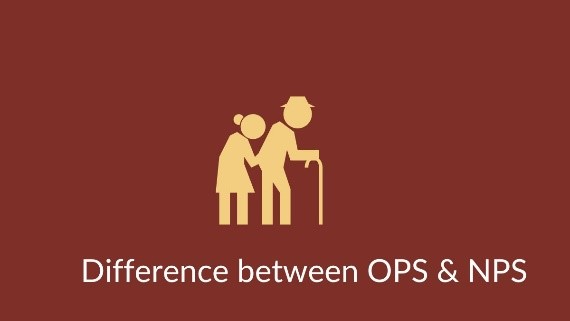Description

Disclaimer: Copyright infringement not intended.
Context
- In a significant decision, the government has decided to give a one-time option to select Central government employees to migrate to the Old Pension Scheme(OPS), who applied for jobs advertised before December 22, 2003
- It is the day the National Pension System (NPS) was notified but joined the service in 2004, when the NPS came into effect.
Details
- The employees have time till August 31 to opt for the OPS.
- The order will be applicable to Central Armed Police Force (CAPF) personnel and other Central government employees who joined the services in 2004 as the recruitment process was delayed due to administrative reasons.
- The employees’ contribution to the NPS will be credited to the General Provident Fund (GPF) of the individual.
.jpeg)
Government’s response
- Government has maintained that restoration to the old system would cause an unnecessary financial burden on the government while several Opposition-ruled States such as Chhattisgarh, Rajasthan, Jharkhand and Himachal Pradesh have announced that they would restore the OPS. Except West Bengal, all States had implemented the NPS.
What Is Old Pension Scheme (OPS)?
- Old Pension Scheme or OPS is a post-retirement benefit for government sector employees that assured a definite amount to be paid to the employee after his superannuation. It was replaced by a New Pension Scheme, which came into effect on 1st April, 2004.
- Popularly known as ‘Defined Benefit Scheme’, OPS secured the future of government employees with an amount which is 50% of their basic salary.
- So, if the basic salary is Rs 10,000, the person would receive a fixed amount of Rs 5,000 per month as pension from the government. With an increase in Dear Allowance twice a year, the government tries to balance the salary with the rising cost of living. Hike in DA also gives way for a higher salary and hence higher pension.
Who pays the amount in OPS?
- The entire amount of the Old Pension was paid by the government. The budget for pensions used to be announced during the Budget announcement every year. Furthermore, the federal and state government were responsible for the payment of the yearly DA increase in the pension as well.
Why was OPS stopped?
- OPS was a financial liability for the government without any source to derive income from the corpus collected as savings of the government employee. Though the announcement would be made every year, the carrying forward capacity of the scheme was not certain.
- The BJP-led NDA government in December 2003 announced to replace the Old Pension Scheme by New Pension Scheme (NPS) from 1st April, 2004.
New Pension Scheme (NPS)
- The scheme is common for all salaried and non-salaried persons across the country. Anyone can subscribe to this scheme. The difference is that in the OPS the government used to provide a fixed amount while in NPS, the market has a role to play as the amounts are invested. The amount investors get as annuity is less than what is given in OPS.
- In this scheme, the employee has to contribute 10% of his salary while the employer makes an equal contribution.

The key differences between OPS and NPS are in the following:
OPS
- The old pension scheme used to give a fixed monthly income to government employees after retirement.
- It provided 50 per cent of the last drawn salary as a pension.
- No tax benefits are applicable to the employees.
- Income under the old pension scheme doesn't attract tax.
- Only government employees are eligible to receive a pension under the OPS after retirement.
NPS
- The NPS is also meant for government employees. However, private sector employees can also join NPS.
- In NPS, employees contribute money from their salary during their employment tenure. The amount is invested in market-linked instruments.
- Investment in NPS up to Rs 1.50 lakh is tax-deductible under Section 80C of the Income Tax Act, 1961. Additional annual investments up to Rs 50,000 are tax-deductible under Section 80CCD (1B) of the Act.
- After retirement, an employee can withdraw a part of the pension amount in a lump sum. According to the rule, 60 percent of the corpus on maturity is tax-free, while the remaining 40 percent is taxable and must be invested in annuities for a regular income or pension.
- NPS is mandatorily applicable to central government employees except armed forces recruited on or after January 1, 2004. State governments also follow the NPS for their employees.
- Under the NPS, employees make a monthly contribution at the rate of 10 per of their salary. A matching contribution is also made by the government. Starting April 1, 2019, the employer’s contribution rate has been enhanced to 14 per cent for the central government employees.
- All citizens between 18 and 65 years are eligible for NPS.
|
PRACTICE QUESTION
Q) Which of the following statements is/are correct?
a. Investment in New Pension Scheme up to Rs 1.50 lakh is tax-deductible under Section 80C of the Income Tax Act, 1961.
b. NPS is mandatorily applicable to all central government employees recruited on or after January 1, 2004.
i. Only a
ii. Only b
iii. a and b
iv. None of the above.
Answer: Option i
|

Array
(
[0] => daily-current-affairs/old-pension-scheme-vs-new-pension-scheme
[1] => daily-current-affairs
[2] => old-pension-scheme-vs-new-pension-scheme
)








